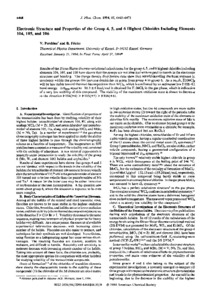Electronic structure and properties of the group 4, 5 and 6 highest chlorides including elements 104, 105, and 106
| dc.date.accessioned | 2008-10-22T07:40:22Z | |
| dc.date.available | 2008-10-22T07:40:22Z | |
| dc.date.issued | 1994 | |
| dc.identifier.issn | 0022-3654 | |
| dc.identifier.issn | 0092-7325 | |
| dc.identifier.uri | urn:nbn:de:hebis:34-2008102224726 | |
| dc.identifier.uri | http://hdl.handle.net/123456789/2008102224726 | |
| dc.format.extent | 747925 bytes | |
| dc.format.mimetype | application/pdf | |
| dc.language.iso | eng | |
| dc.rights | Urheberrechtlich geschützt | |
| dc.rights.uri | https://rightsstatements.org/page/InC/1.0/ | |
| dc.subject.ddc | 530 | |
| dc.title | Electronic structure and properties of the group 4, 5 and 6 highest chlorides including elements 104, 105, and 106 | eng |
| dc.type | Aufsatz | |
| dcterms.abstract | Results of the Dirac-Slater discrete variational calculations for the group 4, 5, and 6 highest chlorides including elements 104, 105, and 106 have shown that the groups are not identical with respect to trends in the electronic structure and bonding. The charge density distribution data show that notwithstanding the basic increase in covalency within the groups this increase diminishes in going from group 4 to group 6. As a result, E106Cl_6 will be less stable toward thermal decomposition than WCl_6, which is confirmed by an estimated low E106-Cl bond energy. \delta H_form equal to -90.3 ± 6 kcal/rnol is obtained for E106Cl_6 in the gas phase, which is indicative of a very low stability of this compound. The stability of the maximum oxidation state is shown to decrease in the direction E104(+4) > E105(+5) > E106(+6). | eng |
| dcterms.accessRights | open access | |
| dcterms.bibliographicCitation | In: The Journal of Physical Chemistry. - Washington, DC : Soc.. - Easton, Pa., 98.1994, S. 6468 - 6473 | |
| dcterms.creator | Pershina, Valerija G. | |
| dcterms.creator | Fricke, Burkhard |
Files in this item
This item appears in the following Collection(s)
-
Publikationen [132]

